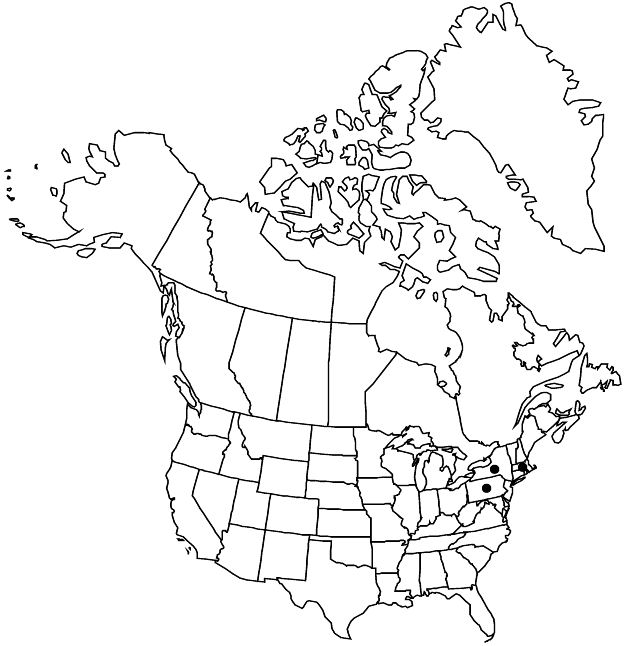Difference between revisions of "Crataegus stonei"
Rhodora 5: 62. 1903.
FNA>Volume Importer |
imported>Volume Importer |
||
| (6 intermediate revisions by 2 users not shown) | |||
| Line 19: | Line 19: | ||
|name=Crataegus biltmoreana var. stonei | |name=Crataegus biltmoreana var. stonei | ||
|authority=(Sargent) Kruschke | |authority=(Sargent) Kruschke | ||
| + | |rank=variety | ||
}} | }} | ||
|hierarchy=Rosaceae;Rosaceae subfam. Amygdaloideae;Rosaceae tribe Gillenieae;Crataegus;Crataegus sect. Coccineae;Crataegus (sect. Coccineae) ser. Intricatae;Crataegus stonei | |hierarchy=Rosaceae;Rosaceae subfam. Amygdaloideae;Rosaceae tribe Gillenieae;Crataegus;Crataegus sect. Coccineae;Crataegus (sect. Coccineae) ser. Intricatae;Crataegus stonei | ||
| Line 35: | Line 36: | ||
|distribution=Mass.;N.Y.;Pa. | |distribution=Mass.;N.Y.;Pa. | ||
|discussion=<p>Of conservation concern.</p><!-- | |discussion=<p>Of conservation concern.</p><!-- | ||
| − | --><p>Crataegus stonei is another species related to C. biltmoreana, from which it differs mainly in its pink anthers, proportionately narrower and more elongate leaves, and lower stature.</p> | + | --><p><i>Crataegus stonei</i> is another species related to <i>C. biltmoreana</i>, from which it differs mainly in its pink anthers, proportionately narrower and more elongate leaves, and lower stature.</p> |
|tables= | |tables= | ||
|references= | |references= | ||
| Line 44: | Line 45: | ||
-->{{#Taxon: | -->{{#Taxon: | ||
name=Crataegus stonei | name=Crataegus stonei | ||
| − | |||
|authority=Sargent | |authority=Sargent | ||
|rank=species | |rank=species | ||
| Line 59: | Line 59: | ||
|publication year=1903 | |publication year=1903 | ||
|special status=Conservation concern;Endemic | |special status=Conservation concern;Endemic | ||
| − | |source xml=https:// | + | |source xml=https://bitbucket.org/aafc-mbb/fna-data-curation/src/2e0870ddd59836b60bcf96646a41e87ea5a5943a/coarse_grained_fna_xml/V9/V9_1008.xml |
|subfamily=Rosaceae subfam. Amygdaloideae | |subfamily=Rosaceae subfam. Amygdaloideae | ||
|tribe=Rosaceae tribe Gillenieae | |tribe=Rosaceae tribe Gillenieae | ||
Latest revision as of 22:53, 5 November 2020
Shrubs, 10–20 dm. Stems: twigs: new growth reddish green, glabrous or villous, 1-year old dull reddish brown, eventually gray; thorns on twigs ± straight, 2-years old blackish, ultimately gray, ± slender, 4–6 cm. Leaves: petiole length 30–40% blade, winged distally, villous, glandular; blade narrowly ovate, 7–8 cm, base cuneate, lobes 0 or 1–3 per side, sinuses shallow, lobe apex acute, margins serrate, teeth gland-tipped, veins 4 or 5 per side, apex acuminate, abaxial surface sparsely villous along veins, adaxial sparsely villous. Inflorescences 4–6-flowered; branches villous; bracteoles not seen. Flowers 18–20 mm diam.; hypanthium densely pubescent; sepal length not recorded, margins coarsely glandular-serrate, acuminate, abaxially pubescent; stamens 5–10, anthers pink; styles 3 or 4. Pomes dull yellow to russet, broadly ellipsoid, 12–14 mm diam., hairy; sepals on collar, ± reflexed; pyrenes 3 or 4.
Phenology: Flowering late May–early Jun; fruiting Sep–Oct.
Habitat: Woods, openings
Elevation: 20–300 m
Distribution

Mass., N.Y., Pa.
Discussion
Of conservation concern.
Crataegus stonei is another species related to C. biltmoreana, from which it differs mainly in its pink anthers, proportionately narrower and more elongate leaves, and lower stature.
Selected References
None.